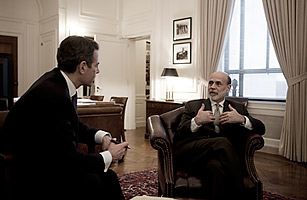
TIME's Managing Editor Richard Stengel talks with Federal Reserve Chairman Ben Bernanke during an interview in Washington, DC
(2 of 12)
Shortly after the failure of Lehman Brothers, I was in Brazil at an international meeting, and I had a meeting there with bankers, and I asked them how the Brazilian economy was doing. And they said well, it had been doing fine, but within a week after Lehman Brothers collapsed, it was like a frigid wind descended on the economy in Brazil. And there was an enormous impact almost immediately on their economy, on their ability to raise funds and make loans. And it's astonishing how quickly that one failure spread throughout the world, and created a very severe recession, not just in the U.S., but around the world.
So, we knew that if this crisis was allowed to expand, and to bring down not just one major institution, but 10, or 15, or 20, which seemed very likely at the time, that the consequences for every single person in the world, for every American, would have been extraordinarily dangerous and adverse. It would have had very, very bad consequences for the entire economy.
So, the Federal Reserve, along with the Treasury, moved aggressively to try to stop the crisis. We took a number of measures. The most controversial, and most unpleasant, and distasteful measure that we took was to prevent the failure of the insurance company, AIG. A small portion of that company had been engaged in risky financial bets, which had not been regulated, which had not been monitored appropriately. And because of those risky financial bets, the company was in immediate danger of failing within in hours. And, in doing so, it would have exacerbated the crisis, and probably brought many other institutions to the ground.
The Federal Reserve, by making a large loan under very tough terms to AIG, prevented the failure of that institution, and, therefore, tried to contain the impact of the Lehman Brothers failure on the rest of the global financial system. I'll come back and talk more about AIG, and those things later, but that was just the first step of many that we took to try to stop the crisis.
Subsequently, again, very concerned with the possibility of a global financial meltdown, we worked with Treasury and the Congress to develop a bill that would provide funding that the Fed, the Treasury and other agencies could use to stabilize the financial system, to prevent collapse of the financial system.
This immediately became relevant, because in mid-October, the crisis heated up again to the point that we thought that we were again within days or hours of a collapse of many of the largest financial firms in the world. It was a dramatic weekend. It was Oct. 10 or 11, Columbus Day weekend, when the Finance Ministers and the central bankers of seven of the largest industrial economies had a meeting here in Washington, which, of course, I attended. Usually, those meetings are very scripted and very dry. In this case, there was palpable concern among the participants that the collapse of their financial system might be just days away, and there was a great deal of discussion about how we, collectively, as the policy makers leading those countries could stop the collapse.
In the days that followed, countries all over the world, particularly the advanced industrial countries, took strong measures to prevent the collapse of the financial systems. That included putting capital into banks; it included preventing the failure of large financial firms; it included guaranteeing the debts of financial firms so they could borrow and keep themselves afloat; it included making short-term loans to firms so that they would have the short-term credit they needed to pay off lenders who were withdrawing their funding. And, again, this was the U.S. doing this, but also many of the most important industrial countries around the world simultaneously, including the U.K., Germany, France, Switzerland and others.
The result of this collective global effort over that week was essentially to succeed in stabilizing the global banking system, in that subsequent to that week the fears of utter collapse were largely overcome.
Now, in the following months after that, there were still many, many great difficulties in the financial markets. And the Fed, and other central banks and Treasuries around the world, worked very hard to restore the normal functioning of those markets. For example, following the Lehman failure, there was a run where ordinary investors went as quick as they could to pull their money out of money market mutual funds, which are a common investment vehicle for many Americans. It was very analogous to 100 years ago when a bank was about to fail, and the depositors would go to the bank, they would run and pull their money out as quickly as possible, and then the bank would fail. The money market mutual funds were experiencing exactly the same phenomenon.
The Fed and the Treasury working together provided short-term loans to these funds. The Treasury provided some insurance to depositors, or to investors so they would know they wouldn't lose their money. We stopped the run on the money market mutual funds, and that was an example of how we helped stabilize the situation.
There were many other steps we had to take helping individual institutions, and providing programs for backstop lending to make sure that the key markets in the financial system were functioning again, because for months after Lehman Brothers, the amount of fear and uncertainty in the financial markets was so elevated that these markets were, essentially, not functioning properly, and it took really many months until we had reached the point that these markets had begun to approach a normal state.